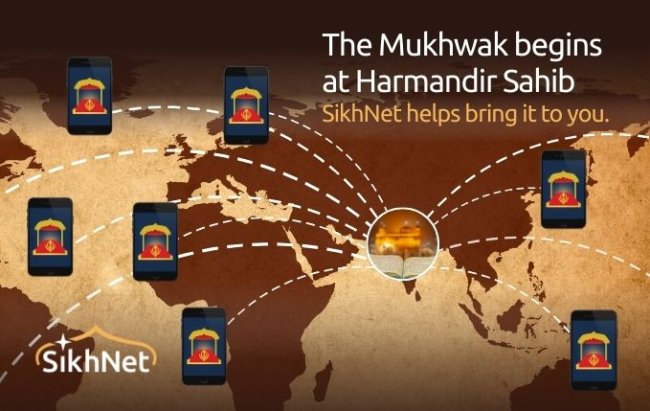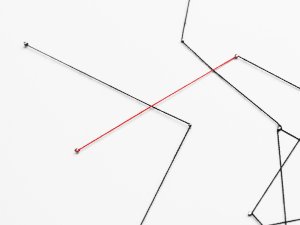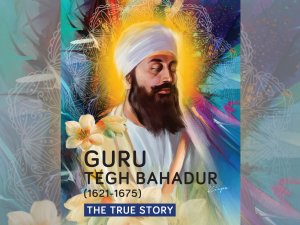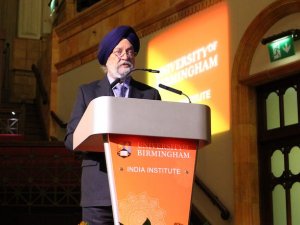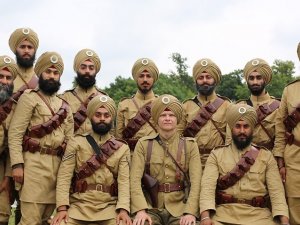Gur-Sangat keeni Khalsa - Vaaran Bhai Gurdas, Vaar 41 (by Bhai Gurdas II )
Many years ago, Dr J S Grewal, renowned historiographer and, at that time, the Visiting Distinguished Professor at University of Wisconsin-Milwaukee, left with me a research paper, Gur Sangat Kini Khalsa1 .
Ever since, I have been meaning to return to Dr Grewal's paper when I hear this quote by some Gurdwara parcharak (preacher). What does it really mean?
Recently an invitation by Sikhnet to write about some aspect of the life of Guru Gobind Singh ji, prompted me to return to this topic. It was Guru Gobind Singh ji who revealed Waheguru ji ka Khalsa i.e. Waheguru's Khalsa, from the Sangat assembled at Anandpur Sahib on the Vaisakhi Day in 1699. "Revealed" (pragtyo) because the Khalsa was always there in the Guru's Sangat or Gur-Sangat.
The Guru then partook Amrit from the Khalsa represented by the Panj Piaray (Five Beloved Ones)and himself became Khalsa, Guru Gobind Singh. As "aapay Gur chela" (himself the Guru and himself the disciple), Guru ji removed the distinction between the Guru and the Khalsa.
With the Khalsa-Waheguru link established, the need for a human Guru's intercession was no longer necessary. The Eternal Word of the Guru, as Sri Guru Granth Sahib, was always there to guide the Khalsa Panth.
Gur-Sangat keeni Khalsa, leads one to understand the spiritual-temporal continuity of Sikh thought from Sangat to Waheguru ji ka Khalsa. It also shows us the processes which ensured the ultimate victory of the Khalsa against almost impossible odds over the centuries.
The expression is a quote from Vaar (ballad) 41 of Vaaran Bhai Gurdas written by Bhai Gurdas Singh towards the end of the 18th century. References at pauris (stanzas) 19 and 22 indicate that this Vaar was written by Bhai Gurdas Singh about 80 years after Gur Sobha by Sainapat Singh completed in 1711 i.e. within three years of Guru Gobind Singh ji's departure for Sach Khand.
In his introduction, Dr Grewal refers back to his research of Gur Sobha2
However, it was only after reading Dr Ganda Singh's introduction to "Sri Gur Sobha" (Punjabi) that I realized the full import of Gur Sangat keeni Khalsa in the context of Sikh-Khalsa evolution to full Waheguru ji ka Khalsa.
Sangats (congregations) were set up all over the Indian sub-continent and beyond during the time of Guru Nanak Dev ji. Sangat (from word "sang" meaning company) has both, spiritual as well as temporal, aspects.
Sangat is a religious congregation as well as an association.
So Sangats from the days of Guru Nanak Sahib, were both, holy congregations where the Guru's Word was preached and meditated on. They were also local associations led by prominent Sikhs. Many Sangats and hundreds of these leading Sikhs are mentioned in the extensive travels of the Gurus with vaheers (large body of families on the move 3) and in the Hukamnamas ( Commands) issued by the Gurus.
By appointing local representatives (manji-holders) Guru Amardas ji further organized the Sangat system. Prominent Sikh parcharaks were appointed by the Guru. Periodically, they came for the Guru's holy darshan and also brought the Sangats' donations for the Guru's community langar and services. Not all, but many members of the Sangat accompanied these local representatives of the Guru. Thus we have numerous references to Sangats from various parts of the country and even from places like Kabul, coming for Guru ji's darshan. They spent time in the company of the Guru, holding Gurmat discourses.
It was inevitable that the rapidly growing Sikh Panth - religio-temporal path or organization - thus resourced and spiritually sustained by the network of Sangats, could no longer remain below the radar of the Mughal emperors of Delhi. The Islamic state could not accept the growth of another religious path (referred to as Tisra Mazhab by Bhai Gurdas Singh).
Guru Arjan Dev ji was martyred as a result. Guru Tegh Bahadur ji's unique martyrdom for another religion while upholding the universal principle of religious freedom - yet to be recognized at global level by the United Nations - came next.
After Guru Nanak Sahib, Guru Tegh Bahadur ji is most prominent for extensive travels with vaheer to distant places in the northern districts of the sub-continent. Sangats were further revived and organized, and many new Sangats were estalished.
Over time, next generations of local parcharaks, became lax about passing on Sangats' donations to the Guru. There were frequent complaints reaching the Guru darbar about misappropriation of donations by these masands (Guru's preacher-cum-collectors of daswandh or tithe).
Part reason was the ongoing dispute about Gurgadhi within Guru's household which eventually reached the emperors of Delhi who, like Aurungzeb, took personal interest to frustrate what was seen as a growing threat of egalitarian Sikh movement.. There were many gurus with their own masands. One such masand Sheehan of Baba Dhir Mal, a pretender to guruship, even fired on Guru Tegh Bahadur at Bakala.
Dr Ganda Singh dwells at length on the extreme corruption of some masands and how the Sangats were commanded by the Guru to take donations directly to the Guru.
Thus the masands were removed and Sangats were made Guru's Khalsa .
During the Mughal period, in the official language, the land or district directly owned, or the land revenue directly received, by the emperor, was called khalsa. When the medium of landowners or jagirdars (feudal lords) was removed from receiving land revenue (maalia), so that it was received directly by the Mughal emperor, the land became khalsa.
It is in this sense that the expression Khalsa was first used by the Gurus, starting with Guru Hargobind Sahib, in the Hukamnamas e.g. "Purab di Sangat Guru da Khalsa hai" (The Sangat of the East is the Khalsa of the Guru), or same wording for the Sangat of Patan, "Patan di Sangat Sri Guru ji ka Khalsa hai" - Hukamnamas of Guru Hargobind and Guru Tegh Bahadur respectively (Dr Ganda Singh, Hukamnaamay 3 and 8, Punjabi University).
Poet Sainapat writes, "Kar masand sabh door, Khalsa kar leeaa." The masands were removed and [the Sanagat] was made Khalsa. (Sri Gur Sobha 32.148)
Gur Sangat keeni Khalsa was important from the funding aspect of the Khalsa mission. Here we need to keep in mind that the Sangats set up by Guru Nanak Sahib all over Indian subcontinent and even beyond and later visited by Guru Tegh Bahadur in most of northern India, sustained Guru Nanak's mission through their daswandh (tithes)
The Khalsa Sangat now contributed directly to the success of the Khalsa Panth. The prolonged Khalsa sangharash (struggle) of the 18th century was thus sustained and the Khalsa of the Guru proved to be more than a match for the imperial army.
Bhai Gurdas Singh who wrote Vaar 41 came much later when the Mughal had been defeated by the Khalsa armies called Misls, towards the end of the 18th century. The poet confirms that at the time of his writing, the Emperor Aurungzeb's family had perished as a result of his evil deeds.
Vaar 41 celebrates the victory of the Khalsa Panth and sings the praises of God and the Gurus. "Thus we can see that the author dwells mainly on three themes,: God, the Gurus and the Sangat." (Dr J S Grewal). These themes are consistent with main-stream Sikh ideology.
God is described essentially in accordance with the founding precept of Guru Nanak and the Bani of Guru Gobind Singh ji. Dr Grewal continues, "Bhai Gurdas Singh's conception of God is characteristically Sikh. For Bhai Gurdas Singh, God is the only object of worship..…All the ideas associated with divine self-expression find mention in Bhai Gurdas Singh's Vaar: the Truth, the Guru, the Name, the Shabad, the Hukam, and the nadar….In the Vaar of Bhai Gurdas Singh we find ,thus, the same theology as the theology of the Gurus from Guru Nanak to Guru Gobind Singh…Guru Nanak is at the head of line of ten Gurus. He is not God but he is closely allied with divinity."
The continuity and progress of Guru Nanak Sahib's Sikhi mission is shown through the nine Guru-persons. (Pauries 21,22 & 23)
Significantly in the context of those who sow doubts today about the continuity of Guru Nanak's thought through and Guru-persons who followed and the Khalsa Panth, Dr Grewal writes, "We can see that Bhai Gurdas makes no difference between Guru Nanak and his successors. The unity of the Gurus is reinforced by using mahal, pargas and avtar as synonyms. Each carried forward the work of Guru Nanak. The tenth Avatar enabled the followers of Guru Nanak and his successors to safeguard their cherished tradition against oppression and external interference. Bhai Gurdas Singh does not see any appreciable difference between the followers of Guru Nanak and Guru Gobind Singh, In a very real sense they formed one and the same entity…The refrain of these pauris re-inforces the impression that what was true of the Sikh-sangat is true of the Khalsa-sangat. The primacy given to spiritual concerns is very significant."
Guru Gobind Singh ji worshipped God and revealed the Khalsa Panth. "With kesh on their heads and sword in their hands the Khalsa vanquished the enemy. They wore the kachh of sexual control and took up arms. …The worship of God was made manifest in the world."
The Khalsa was revealed as the Tisra Mazhab (Third religious path as distinct from the Hindu and the Muslim) in perfect human form and in accordance with the Hukam of Akal Purakh. The Khalsa was different and distinct from, "the Indic (hindak) tradition represented by the Vedas, the Puranas, the Shastras, the temples and the idols of stone, the yagya and the hom, the Brahman, and Pandit , and the Jotki. The hukam of Akal was made manifest in the world…..The "victory of the Guru" was meant to make the truth prevail." (Vaar 41.15)
The rule of the egalitarian Khalsa was justified because it extended security and freedom of worship according own chosen religious path. Guru Gobind Singh is praised as the disciple of the Primeval Being.
According to Dr Grewal "Both [Sainapat and Gurdas Singh] see divine sanction behind the institution of the Khalsa. For both, the baptism of the double edged sword, the adoption of Singh as a part of name, the keeping of unshorn hair, the wearing of arms formed the salient features of the institution of the Khalsa….The importance of association with the sangat is underlined by both authors."
The processes, procedures and the Sikhi institutions were in place for collective decision making to ensure the continuity of Guru Nanak Sahib's mission.
The Khalsa is of Waheguru and the victory of the Khalsa as Akal Purakh ki fauj - the Army of the Timeless Being - is Waheguru's victory. Thus, Waheguru ji ka Khalsa, Waheguru ji ki fateh.
Wah wah Gobind Singh Aapay Gur-Chela!
Praise be to Gobind Singh who himself is the Guru and the disciple4.
1 According to a footnote, "…published in The Tenth Master. Edited by Harbans Singh, Patiala: Punjabi University, 1967. While passing through Southall, UK, Dr Grewal had dropped in for a chat with some local Sikhs at my place and left some papers with me.
2 J S Grewal, The Khalsa in Gursobha: Sikh Ideology, Polity and Social Order, New Delhi: Manohar, 1966.
3 Sikh vaheers, especially from the time of Guru Hargobind ji, were guarded by armed warriors.
4 The refrain used in the first 28 pauries (stanzas) of Vaar 41 by Bhai Gurdas Singh.
